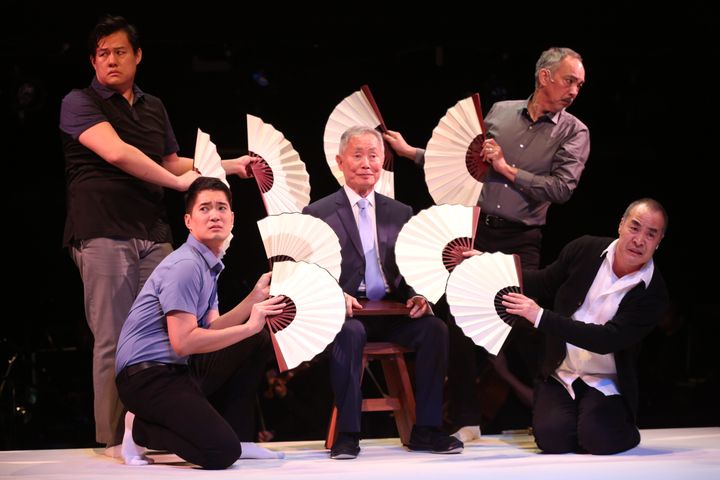
Kelvin Moon Loh, Austin Ku, George Takei, Thom Sesma and Marc Oka in Pacific Overtures
Director John Doyle, who made his name with innovatively spare versions of Stephen Sondheim’s Sweeney Todd and Company—and who dazzled Broadway last season by turning the problematic Color Purple into a crowd-pleasing hit—is at it again. Now, he has set his sights on Sondheim and John Weidman’s 1976 musical Pacific Overtures, a supremely crafted show that has been known to leave audiences impressed but cold. Not this time. By paring the show to its roots (except, thankfully, in the music department), Doyle’s Pacific Overtures makes for altogether terrific theatergoing.
Director/set designer Doyle places his actors on a simple stage platform that curves up to the ceiling on one end and leads to the floor-level orchestra pit on the other. The audience of two hundred or so sits in five rows, on either side of the stage. When the cast looks out, terrified, at Sondheim’s “Four Black Dragons” (i.e. American warships invading the island nation), it is clear: to the besieged natives, we the people are the dragons spitting fire.
Costume designer Ann Hould-Ward follows the scheme with what appears to be contemporary street garb on her cast of ten. No silk kimonos here; and none of those many screens Sondheim refers to in his opening number, “The Advantages of Floating in the Middle of the Sea,” from Mr. Doyle.
The original production of this fourth in the series of six consecutive Sondheim/Hal Prince musicals—it came between A Little Night Music and Sweeney Todd—was distinguished by a massive set which included a ramp leading from the stage to the back of the Winter Garden auditorium, along with museum-quality costumes and masks. Who would have thought that the material would survive without screens, treaty houses, or any scenery at all; and with no clothes?

Steven Eng, Megan Masako Haley and Ann Harada in Pacific Overtures
John Doyle, that’s who. Lo and behold, the almost total lack of production value doesn’t diminish the show; rather, by removing the stylistic wall that we have previously viewed the proceedings through, it enhances the dramatic power. (The effective lighting comes from Jane Cox.) The results, as revealed down at the Classic Stage Company, are far more involving. It turns out that there is indeed a beating heart within the show.
The ten actors smoothly move through the multiple roles. George Takei plays what had formerly seemed to be the central role of The Reciter; here, he is separate from the rest but not nearly as prominent, leading one to wonder just how much the role has been trimmed. Standing out among the others are Thom Sesma, as the Lord and the Old Man (in the Tree); Steven Eng as Kayama; Austin Ku as the Boy (in the Tree) and one of the “Pretty Lady” serenaders; and Ann Harada as the Madam and the French Admiral.
Jonathan Tunick has reduced his 1976 orchestration to nine pieces; a significant reduction, yes, but the results are remarkably good. By mixing a string quartet with two keyboards, two percussionists and one wind player, all colors are covered; and those percussionists really fill the house. (Tunick’s prior reduction, for the 2004 Roundabout revival, had only seven pieces—which leads one to wonder why the scrappy CSC can give Sondheim more musicians than the big-budget Roundabout can?) In any event, the score—from musical director Greg Jarrett and musical supervisor Rob Berman—is perfectly rendered.
Doyle has excised “Chrysanthemum Tea,” which is perhaps the largest group number of the show. (Also gone is the “Lion Dance,” which formerly served as the Act One finale.) This surgery allows the director to compress the action into a compact, ninety-minute playing time. Purists may carp—there’s always someone likely to carp about anything—but if it’s okay by Mr. Sondheim, it’s fine by me. The bigger question is, does Doyle’s production succeed? Rousingly so!

Thom Sesma, Megan Masako Haley, George Takei and Marc Oka in Pacific Overtures
The effect of Pacific Overtures in this guise can be seen throughout the compact evening. The configuration at CSC, with the stage platform placed in the middle of the seating, necessarily presents the viewer with a mirror-image audience across the way. Pacific Overtures is not, and is not intended to be, a “happy” show. But at many spots through the evening—notably but not exclusively during “Someone in a Tree,” “Please Hello” and “A Bowler Hat”—you might well notice that your fellow playgoers are positively beaming. Not because the show is full of chuckles; it’s just that it’s enthralling to see Sondheim’s Pacific songs work so magically well.
Stephen Sondheim and John Weidman’s Pacific Overtures opened May 4, 2017 and runs through June 18 at the Classic Stage Company
